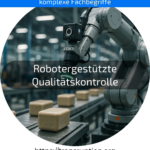The term robot-assisted quality control originates from the fields of Industry and Factory 4.0, automation and robots. It describes the use of robots to automatically check the quality of products during production. The aim is to recognise errors or deviations at an early stage and thus ensure consistently high quality.
Instead of relying on manual checks by humans, companies are using robots equipped with cameras, sensors or lasers. These check, for example, whether components have been assembled correctly or whether there are cracks and scratches in products. The robots often work faster and more accurately than humans, which not only saves time but also reduces costs.
An illustrative example: In a car factory, a robot arm moves over the freshly painted car body and automatically searches for small paint defects or dents. If it finds a defect, the part can be sorted out immediately. Robot-supported quality control thus ensures fewer rejects, improved production processes and satisfied customers, as faulty products hardly ever leave the factory.






